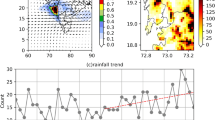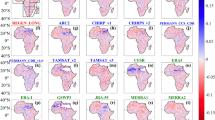Abstract
Statistical downscaling model (SDSM) was applied in downscaling precipitation in the three climatic regions of Nepal. The study includes the calibration of the SDSM model by using large-scale atmospheric variables encompassing National Centers for Environmental Prediction (NCEP) reanalysis data, the validation of the model, and the outputs of downscaled scenarios A2 and B2 of the HadCM3 model for the future. The average R 2 value during validation period was 0.84, indicating the good applicability of SDSM for simulating precipitation. Under both scenarios A2 and B2, during the prediction period of 2010–2099, the change of annual mean precipitation in the three climatic regions would present a tendency of surplus of precipitation as compared to the mean values of the base period. On the average for all three climatic regions of Nepal, the annual mean precipitation would increase by about 13.75 % under scenario A2 and increase near about 11.68 % under scenario B2 in the 2050s. The model showed better performance over humid region; moreover, simulated results for the peak monsoon months seem to be overestimated over subhumid and arid regions.






Similar content being viewed by others
References
Dibike YB, Coulibaly P (2005) Hydrologic impact of climate change in the Saguenay watershed: comparison of downscaling methods and hydrologic models. J Hydrol 307:145–163
Eischeid JK, Pasteris PA, Diaz HF, Plantico MS, Lott NJ (2000) Creating a serially complete, national daily time series of temperature and precipitation for western United States. J Appl Meteorol 39:1580–1591
Fowler HJ, Blenkinsop S, Tebaldi C (2007) Linking climate change modelling to impacts studies: recent advances in downscaling techniques for hydrological modelling. Int J Climatol 27:1547–1578
Harpham C, Wilby RL (2005) Multi-site downscaling of heavy daily precipitation occurrence and amounts. J Hydrol 312:235–255
Hashmi MZ, Shamseldin AY, Melville BW (2010) Comparison of SDSM and LARS-WG for simulation and downscaling of extreme precipitation events in a watershed. Stoch Environ Res Risk Assess. doi:10.1007/s00477-010-0416-x
Huang J, Zhang J, Zhang Z, Xu CY, Wang B, Yao J (2011) Estimation of future precipitation change in the Yangtze River basin by using statistical downscaling method. Stoch Environ Res Risk Assess 25:781–792
Huntingford C, Gash J, Giacomello AM (2006) Climate change and hydrology: next steps for climate models. Hydrol Proc 20–9:2085–2087. doi:10.1002/hyp.6208
IPCC (2007) Climate Change 2007: the physical science basis. In: Solomon S, Qin D, Manning M, Chen Z, Marquis M, Averyt KB, Tignor M, Miller HL (eds) Contribution of Working Group I to the fourth assessment report of the intergovernmental panel on climate change. Cambridge University Press, Cambridge
Kansakar SR, Hannah DM, Gerrard J, Rees G (2004) Spatial pattern in the precipitation regime of Nepal. Int J Climatol 24:1645–1659
Khan MS, Coulibaly P, Dibike Y (2006) Uncertainty analysis of statistical downscaling methods. J Hydrol 319:357–382
Koukidis EN, Berg AA (2009) Sensitivity of the Statistical DownScaling Model (SDSM) to reanalysis products. Atmos Ocean 47(1):1–18. doi:10.3137/AO924.2009
Mahmood R, Babel M (2013) Evaluation of SDSM developed by annual and monthly sub-models for downscaling temperature and precipitation in the Jhelum basin, Pakistan and India. Theor Appl Climatol 113:27–44
Salzmann N, Frei C, Vidale P-L, Hoelzle M (2007) The application of Regional Climate Model output for the simulation of high-mountain permafrost scenarios. Global Planet Change 56(1–2):188–202. doi:10.1016/j.gloplacha.2006.07.006
Timbal B, Fernandez E, Li Z (2009) Generalization of a statistical downscaling model to provide local climate change projections for Australia. Environ Model Softw 24:341–358
Wilby RL, Dawson CW (2007) Using SDSM Version 4.1 SDSM 4.2.2-a decision support tool for the assessment of regional climate change impacts. User Manual, Leicestershire, UK
Wilby RL, Harris I (2006) A framework for assessing uncertainties in climate change impacts: low-flow scenarios. Water Resour Res 42:W02419. doi:10.1029/2005WR004065
Wilby RL, Wigley TML, Conway D, Jones PD, Hewitson BC, Main J, Wilks DS (1998) Statistical downscaling of general circulation model output: a comparison of methods. Water Resour Res 34(11):2995–3008
Wilby RL, Dawson CW, Barrow EM (2002) SDSM—a decision support tool for the assessment of regional climate change impacts. Environ Model Softw 17:147–159
Williams TO, Tarawali S, Hiernaux P, Fernandez-Rivera S (eds) (2004) Sustainable crop-livestock production for improved livelihoods and natural resource management in West Africa. Proceedings of an international conference held at the International Institute of Tropical Agriculture (IITA), Ibadan, Nigeria, November 19–22, 2001, 528p. Nairobi (Kenya): ILRI./Wageningen (The Netherlands): CTA
Acknowledgments
We would like to thank Robert L. Wilby and Rashid Mahmood for suggesting on the queries about the SDSM methodology. Similarly, we acknowledge the Department of Hydrology and Meteorology of Nepal for providing the station data. This research was funded by the Chinese Academy of Sciences (XDB03030201), The CMA Special Fund for Scientific Research in the Public Interest (GYHY201406001), the National Natural Science Foundation of China (91337212, 41275010) and EU-FP7 Projects of "CORE-CLIMAX" (313085).
Author information
Authors and Affiliations
Corresponding author
Rights and permissions
About this article
Cite this article
Sigdel, M., Ma, Y. Evaluation of future precipitation scenario using statistical downscaling model over humid, subhumid, and arid region of Nepal—a case study. Theor Appl Climatol 123, 453–460 (2016). https://doi.org/10.1007/s00704-014-1365-y
Received:
Accepted:
Published:
Issue Date:
DOI: https://doi.org/10.1007/s00704-014-1365-y




